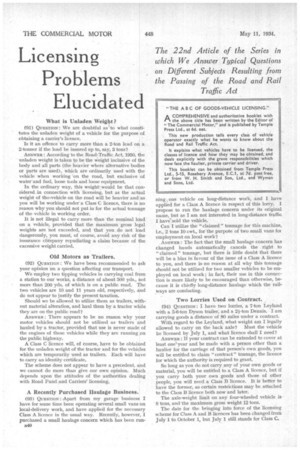Licensing Problems Elucidated
Page 58

If you've noticed an error in this article please click here to report it so we can fix it.
What is Unladen Weight ?
(91) QUESTION: We are doubtful as to what constitutes the unladen weight of a vehicle for the purpose of obtaining a carrier's licence.
Is it an offence to carry more than a 2-ton load on a 2-tonner if the load be insured up to, say, 3 tons?
ANSWER: According to the Road.Traffic Act, 1930, the unladen weight is taken to be the weight inclusive of the body and all parts (the heavier where alternative bodies or parts are used), which are ordinarily used with the vehicle when working on the road, but exclusive of water and fuel, loose tools and loose equipment.
In the ordinary way, this weight would be that considered in connection with licensing, but as the actual weight of theivehicle on the road will be heavier and as you will be working under a Class C licence, there is no reason why you should not put in for the actual tonnage of the vehicle in working order.
It is not illegal to carry more than the nominal load on a vehicle, provided that the maximum gross legal weights are not exceeded, and that you do not load dangerously, you must, of course, avoid any risk of the insurance Caripany repudiating a claim because of the excessive weight carried.
Old Motors as Trailers.
(92) QUESTION: We have been recommended to ask your opinion on a question affecting our transport.
We employ two tipping vehicles in carrying coal from a station to our works, a distance of about 500 yds., not more than 200 yds. of which is on a public road. The two vehicles are 10 and 11 years old, respectively, and do not appear to justify the present taxation.
Should we be allowed to utilize them as trailers, without material alteration, and haul them by a tractor while they are on the public road?
ANSWER: There appears to be no reason why your motor vehicles should not be utilized as trailers and hauled by a tractor, provided that use is never made of the engines of these vehicles while they are running on the public highway.
A Class C licence will, of course, have to be obtained for the unladen weight of the tractor and for the vehicles which are temporarily used as trailers. Each will have to carry an identity certificate.
The scheme does not appear to have a precedent, and we cannot do more than give our own opinion. Much depends upon the attitudes of the authorities dealing with Road Fund and Carriers' licensing.
A Recently Purchased Haulage Business.
(93) QUESTION: Apart from my garage business I have for some time been operating seVeral small vans on local-delivery work, and have applied for the necessary Class A licence in the usual way. Recently, however, I purchased a small haulage concern which has been run
MO ning one vehicle on long-distance work, and I have applied for a Class A licence in respect of this lorry. I propose to run the haulage concern under its original name, but as I am not interested in long-distance traffic I have sold the vehicle.
Can I utilize the " claimed•" tonnage for this machine, i.e., 2 tons 10 cwt, for the purpose of two small vans fin employment on local work?
ANSWER: The fact that the small haulage concern has changed hands automatically cancels the right to " claimed " tonnage, but there is little doubt that there will be a bias in favour of the issue of a Class A licence to you, and there is,no reason at all why this tonnage should not be utilized for two smaller vehicles to be employed on local work ; in fact, their use in this connection is more likely to be encouraged than otherwise, because it is chiefly long-distance haulage which the railways are combating.
Two Lorries Used on Contract.
(94) QUESTION : I have two lorries, a 7-ton Leyland with a 5-6-ton Dyson trailer, and a 21-ton Dennis. I am carrying goods a distance of 80 miles under a contract.
With regard to the Leyland, what weight am I legally allowed to carry on the back axle? Must the vehicle be licensed by July 1, and what licence shall I need?
ANSWER: If your contract can be extended to cover at least one) year and be made with a person other than a haulier for the carriage of that person's own goods, you will be entitled to claim "contract" tonnage, the licence for which the authority is required to grant.
So long as you do not carry any of your own goods or material, you will be entitled to a Class A licence, but if you carry both your own goods and those of other people, you will need a Class B licence. It is better to have the former, as certain restrictions may be attached to the Class B licence both now and later.
The axle-weight limit on any four-wheeled vehicle is • 8 tons, and-the maximum gross weight 12 tons, The date for the bringing into force of the licensing scheme for Class A and B licences has been changed from July 1 to October 1, but July 1 still stands for Class C.




































































































